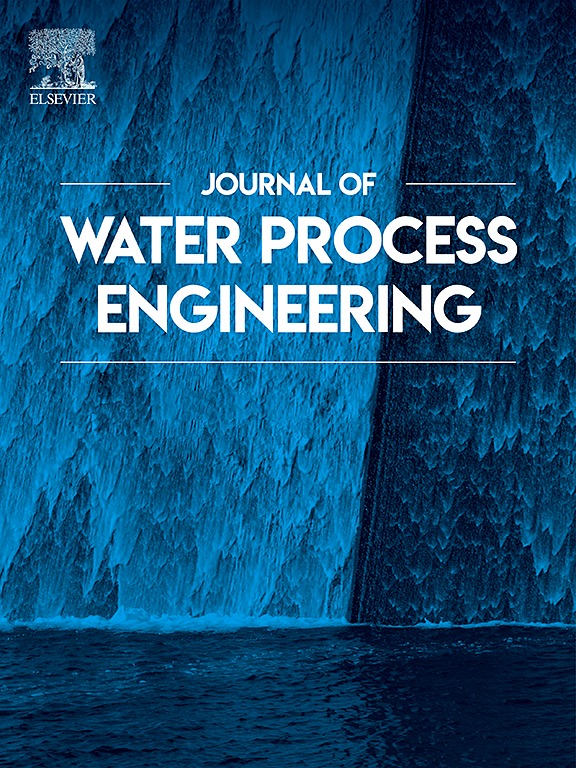Tandem “heterogeneous catalysis/biological degradation” optimization for the treatment of recalcitrant compounds in industrial streams
IF 6.3
2区 工程技术
Q1 ENGINEERING, CHEMICAL
引用次数: 0
Abstract
This study developed a combined Advanced Oxidation Process (AOP)/biological treatment to reduce the recalcitrant organic load in an industrial black liquor from alkaline sulfite pulping. The methodology involved a Fenton-type reaction using a 2.5 % CuO/γ-Al2O3 catalyst, optimized to minimize Cu2+ leaching (reduced Cu2+ leaching from 8.2 mg/L to 1.0 mg/L) and maximize catalyst reuse. The catalyst demonstrated high stability, maintaining effectiveness for up to five cycles. The optimized Fenton pre-treatment enhanced biodegradability, increasing the Biological Oxygen Demand/COD ratio to 0.23 (initial ratio of 0.05), and exhibited minimal toxicity to the microbial community. Subsequent biological treatment was carried out using activated sludge cultured in an aerobic laboratory-scale reactor with partial biomass recycling. Operating conditions were 80 °C, 65.1 mg/L of supported copper (0.32 g of catalyst) and 3.23 g/L of H2O2. The combined AOP/biological system achieved a global 86 % TOC reduction and 93 % COD reduction. With the combination of processes, the current Argentine regulations regarding COD levels in industrial discharges are complied with, adhering to the maximum allowed limit of 250 mg/L in most provinces. Although some Cu leaching occurred, the dissolved copper retained catalytic activity, likely due to complexation with oxidation intermediates. The biological stage effectively treated the pre-oxidized liquor without requiring biomass acclimatization, maintaining microbial activity. These findings confirm the long-term viability of this integrated treatment for industrial applications. Future work should focus on scaling up the process, particularly addressing agitation requirements during the AOP stage.

串联“多相催化/生物降解”优化处理工业废水中顽固化合物
研究了一种高级氧化法(AOP)与生物法相结合的处理方法,以降低碱性亚硫酸盐制浆工业黑液中的难阻性有机负荷。该方法使用2.5% CuO/γ-Al2O3催化剂进行fenton型反应,优化后最大限度地减少Cu2+浸出(将Cu2+浸出从8.2 mg/L降至1.0 mg/L),并最大化催化剂的重复使用。该催化剂表现出高稳定性,可维持5次循环的有效性。优化后的Fenton预处理提高了生物降解性,将生物需氧量/COD比提高到0.23(初始比为0.05),对微生物群落的毒性最小。随后的生物处理是使用实验室规模的好氧反应器中培养的活性污泥进行部分生物质回收。操作条件为:80℃,负载铜65.1 mg/L(催化剂0.32 g), H2O2 3.23 g/L。结合AOP/生物系统实现了86%的TOC减少和93%的COD减少。通过这些工艺的结合,阿根廷目前关于工业排放物中COD水平的规定得到了遵守,在大多数省份都达到了250毫克/升的最高允许限制。虽然发生了一些铜浸出,但溶解的铜保留了催化活性,可能是由于与氧化中间体的络合作用。生物阶段在不需要生物质驯化的情况下有效处理预氧化液,保持微生物活性。这些发现证实了这种综合处理在工业应用中的长期可行性。未来的工作应该集中在扩展过程上,特别是在AOP阶段处理搅拌需求。
本文章由计算机程序翻译,如有差异,请以英文原文为准。
求助全文
约1分钟内获得全文
求助全文
来源期刊

Journal of water process engineering
Biochemistry, Genetics and Molecular Biology-Biotechnology
CiteScore
10.70
自引率
8.60%
发文量
846
审稿时长
24 days
期刊介绍:
The Journal of Water Process Engineering aims to publish refereed, high-quality research papers with significant novelty and impact in all areas of the engineering of water and wastewater processing . Papers on advanced and novel treatment processes and technologies are particularly welcome. The Journal considers papers in areas such as nanotechnology and biotechnology applications in water, novel oxidation and separation processes, membrane processes (except those for desalination) , catalytic processes for the removal of water contaminants, sustainable processes, water reuse and recycling, water use and wastewater minimization, integrated/hybrid technology, process modeling of water treatment and novel treatment processes. Submissions on the subject of adsorbents, including standard measurements of adsorption kinetics and equilibrium will only be considered if there is a genuine case for novelty and contribution, for example highly novel, sustainable adsorbents and their use: papers on activated carbon-type materials derived from natural matter, or surfactant-modified clays and related minerals, would not fulfil this criterion. The Journal particularly welcomes contributions involving environmentally, economically and socially sustainable technology for water treatment, including those which are energy-efficient, with minimal or no chemical consumption, and capable of water recycling and reuse that minimizes the direct disposal of wastewater to the aquatic environment. Papers that describe novel ideas for solving issues related to water quality and availability are also welcome, as are those that show the transfer of techniques from other disciplines. The Journal will consider papers dealing with processes for various water matrices including drinking water (except desalination), domestic, urban and industrial wastewaters, in addition to their residues. It is expected that the journal will be of particular relevance to chemical and process engineers working in the field. The Journal welcomes Full Text papers, Short Communications, State-of-the-Art Reviews and Letters to Editors and Case Studies
 求助内容:
求助内容: 应助结果提醒方式:
应助结果提醒方式:


